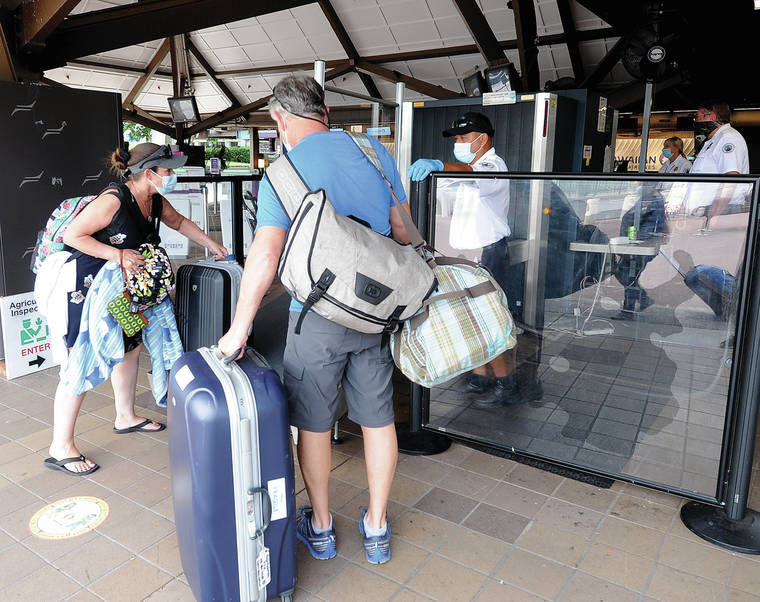Days after approving a request from Kauai Mayor Derek Kawakami that will permit Kauai to temporarily opt out of the state’s Safe Travels program, Gov. David Ige said that the pre-travel testing initiative is working in Hawaii’s other counties.
“Kauai is really calling for a moratorium,” Ige said Monday when asked about the decision during a livestream with the Honolulu Star-Advertiser. “As you know, the COVID counts have actually been quite stable here in Hawaii, except for Kauai.”
Kauai, he said, has experienced a significant increase in the number of coronavirus cases there.
“So they saw a significant increase in the number of travel-related cases — both visitors as well as residents — and they certainly wanted to make sure that their health care system is not overwhelmed by those number of cases.”
Beginning Dec. 2, all trans-Pacific and intercounty travelers arriving in Kauai are subject to a 14-day quarantine.
According to Ige, Kauai intends to rejoin the program as soon as officials can get a handle on the growing number of cases.
However, when asked whether other mayors may opt out of the Safe Travels program, Ige said that all of Hawaii’s mayors are trying to balance public health and economic revival.
“Right now, as I said, the virus counts on all of the islands have remained pretty stable, except for Kauai, and I think the challenge is to bring back trans-Pacific travelers in a safe way and that we don’t see a spike in cases,” he said. “So far, the program is working in the other counties.”
Ige also addressed surveillance testing and said it can prove challenging because once a traveler leaves the airport, it’s hard to track them down and get them to participate in the testing program.
“The other part of that equation is, if someone is aware that should they test positive after being here, it will ruin their vacation, they don’t have the appropriate incentive to try and participate in a voluntary program,” he said. I think that’s been the challenge for all of us.”
While Ige said he would support a two- or three-test program,but the state has to manage Hawaii’s limited resources.
“We only have limited testing capacity here in the state of Hawaii, and if we need to send the test out of state, it takes too long to get the results,” he said.
“We believe the Safe Travels program is working right now,” he added.
Ige last week tightened travel restrictions, requiring all trans-Pacific travelers to have a negative COVID-19 test result from a trusted testing partner before departing to Hawaii in order to bypass a mandatory two-week quarantine.
That means that test results will not be accepted once the traveler arrives in Hawaii. Those who don’t have a negative test result prior to their departure to Hawaii must self-quarantine for 14 days or the length of their stay, whichever is shorter.
According to Ige, just under 300 travelers have come into Hawaii only to be informed of a positive test result after arriving.
That created some additional challenges for the state, Ige said. Some of those who tested positive after arrival experienced hotel cancellations and were put on a do-not-board list by the U.S. Centers for Disease Control and Prevention, unable to leave the state 14 days.
If the close contacts of those 300 individuals have to be isolated, thousands could end up on a no-fly list, unable to leave, he said.
“And that’s the challenge,” he said. “How do we set up a program that can accommodate them?”
Those 300 individuals are part of the Safe Travels program, many of whom had pending tests. Some also were tested after arriving, and others were part of the state’s surveillance testing program. When asked about difficulties some might have in getting test results in 72 hours, Ige said the state recognizes that in areas where the virus is surging, it will be difficult to get a test, “and that’s part of why we’re saying the need to have (a) test in hand.”
Ige said the state wants to establish a broader network of testing partners to ensure people can get the required tests.
“But by the same token, those communities where the virus is surging, we definitely don’t want to have people coming here if they are having trouble getting a test,” he continued. “We are seeing more asymptomatic people who don’t have any signs of illness. … That’s why we want to find that balance of assuring people can get tested but getting the test result in hand so that we’re not left with the challenge of having a COVID-positive traveler here in the islands.”
Since implementing the Safe Travels program in mid-October, Ige said the state’s economy has improved.
Hotels are reopening, hundreds of employees have been brought back to work, and the unemployment rate is slowly dropping, he said.
Email Stephanie Salmons at ssalmons@hawaiitribune-herald.com.






